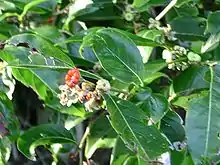Glochidion
Glochidion is a genus of flowering plants, of the family Phyllanthaceae, known as cheese trees or buttonwood in Australia, and leafflower trees in the scientific literature. It comprises about 300 species,[1] distributed from Madagascar to the Pacific Islands. Glochidion species are used as food plants by the larvae of some Lepidoptera species including Aenetus eximia and Endoclita damor.[2] The Nicobarese people have attested to the medicinal properties found in G. calocarpum, saying that its bark and seed are most effective in curing abdominal disorders associated with amoebiasis.[3]
| Glochidion | |
|---|---|
 | |
| Glochidion ramiflorum | |
| Scientific classification | |
| Kingdom: | Plantae |
| Clade: | Tracheophytes |
| Clade: | Angiosperms |
| Clade: | Eudicots |
| Clade: | Rosids |
| Order: | Malpighiales |
| Family: | Phyllanthaceae |
| Subfamily: | Phyllanthoideae |
| Tribe: | Phyllantheae |
| Genus: | Glochidion J.R.Forst. & G.Forst. |
| Species | |
|
About 300, see text | |
Glochidion are of note in the fields of pollination biology and coevolution because they have a specialized mutualism with moths in the genus Epicephala (leafflower moths), in which the moths actively pollinate the flowers—thereby ensuring that the tree may produce viable seeds—but also lay eggs in the flowers' ovaries, where their larvae consume a subset of the developing seeds as nourishment.[4][5][6] Other species of Epicephala are pollinators, and in some cases, non-pollinating seed predators, of certain species of plants in the genera Phyllanthus[7][8] and Breynia,[9][10] both closely related to Glochidion.[11] This relationship is similar to those between figs and fig wasps and yuccas and yucca moths.
Although the genus Glochidion is native only to the Old World, the East Asian species Glochidion puberum has become naturalized at several locations in the U.S. state of Alabama.[12][13]
In a 2006 revision of the Phyllanthaceae, it was recommended that Glochidion be subsumed in Phyllanthus.[14] New combinations in Phyllanthus have been published for Madagascar[15] and the Pacific Islands,[16] but most remain to be published.
Selected species
An incomplete listing:
- Glochidion apodogynum Airy Shaw[17]
- Glochidion barronense Airy Shaw[17]
- Glochidion benthamianum Domin[17]
- Glochidion bourdillonii
- Glochidion calocarpum
- Glochidion christophersenii
- Glochidion carrickii
- Glochidion comitum
- Glochidion disparipes Airy Shaw[17]
- Glochidion eriocarpum
- Glochidion ferdinandi (Mull.Arg.) F.M.Bailey - cheese tree, buttonwood, pencil cedar, water gum, rain tree[17]
- Glochidion gardneri (Thwaites.)
- Glochidion grantii
- Glochidion harveyanum Domin - buttonwood, daphne buttonwood[17]
- Glochidion hylandii Airy Shaw[17]
- Glochidion insulare
- Glochidion johnstonei
- Glochidion lanceolarium
- Glochidion lobocarpum (Benth.) F.M.Bailey[17]
- Glochidion longfieldiae
- Glochidion manono
- Glochidion marchionicum
- Glochidion moonii
- Glochidion moorei
- Glochidion myrtifolium
- Glochidion nadeaudii
- Glochidion orientalis
- Glochidion papenooense
- Glochidion pauciflorum
- Glochidion perakense Hook.f. - umbrella cheese tree, buttonwood[17]
- var. supra-axillare (Benth.) Airy Shaw[17]
- Glochidion philippicum (Cav.) C.B.Rob.[17]
- Glochidion pitcairnense
- Glochidion pruinosum Airy Shaw[17]
- Glochidion puberum
- Glochidion pungens Airy Shaw[17]
- Glochidion raivavense
- Glochidion ramiflorum J.R.Forst. & G.Forst.
- Glochidion rapaense
- Glochidion seemannii Müll.-Arg.
- Glochidion sessiliflorum Airy Shaw[17]
- Glochidion sisparense
- Glochidion stellatum
- Glochidion stylosum
- Glochidion sumatranum Miq.[17]
- Glochidion symingtonii
- Glochidion taitense
- Glochidion temehaniense
- Glochidion tomentosum
- Glochidion tooviianum
- Glochidion xerocarpum (O.Schwarz) Airy Shaw[17]
References
- Carl T. Bergstrom; Lee Alan Dugatkin (2012). Evolution. Norton. p. 630. ISBN 978-0-393-92592-0.
- PLANTS Profile. USDA.gov. Accessed June 2, 2012.
- See p. 412 in: Hammer, K (1990). "Barilla (Salsola soda, Chenopodiaceae)". Economic Botany. 44 (3): 410–412. doi:10.1007/bf03183925. JSTOR 4255259 – via JSTOR.
- Kato, M.; Takimura, A.; Kawakita, A. (2003). "An obligate pollination mutualism and reciprocal diversification in the tree genus Glochidion (Euphorbiaceae)". Proceedings of the National Academy of Sciences of the USA. 100 (9): 5264–5267. doi:10.1073/pnas.0837153100. PMC 154333. PMID 12695568.
- Hembry, D. H.; Okamoto, T.; Gillespie, R. G. (2012). "Repeated colonization of remote islands by specialized mutualists". Biology Letters. 8: 258–261. doi:10.1098/rsbl.2011.0771. PMC 3297384. PMID 21900312.
- Luo, S.-X.; Yao, G.; Wang, Z.; Zhang, D.; Hembry, D. H. (2017). "A novel, enigmatic basal leafflower moth lineage pollinating a derived leafflower host illustrates the dynamics of host shifts, partner replacement, and apparent co-adaptation in intimate mutualisms" (PDF). The American Naturalist. 189: 422–435. doi:10.1086/690623.
- Kawakita, A.; Kato, M. (2004). "Evolution of obligate pollination mutualism in New Caledonian Phyllanthus (Euphorbiaceae)". American Journal of Botany. 91: 410–415. doi:10.3732/ajb.91.3.410.
- Kawakita, A.; Kato, M. (2009). "Repeated independent evolution of obligate pollination mutualism in the Phyllantheae-Epicephala association". Proceedings of the Royal Society B. 276: 417–426. doi:10.1098/rspb.2008.1226. PMC 2664352. PMID 18948251.
- Kawakita, A.; Kato, M. (2004). "Obligate pollination mutualism in Breynia (Phyllanthaceae): further documentation of pollination mutualism involving Epicephala moths (Gracillariidae)". American Journal of Botany. 91: 1319–1325. doi:10.3732/ajb.91.9.1319.
- Zhang, J.; Wang, S.; Li, H.; Hu, B.; Yang, X.; Wang, Z. (2012). "Diffuse coevolution between two Epicephala species (Gracillariidae) and two Breynia species (Phyllanthaceae)". PLOS One. 7: e41657. doi:10.1371/journal.pone.0041657. PMC 3407192. PMID 22848559.
- Kathriarachchi, H.; Samuel, R.; Hoffmann, P.; Mlinarec, J.; Wurdack, K. J.; Ralimanana, H.; Stuessy, T. F.; Chase, M. W. (2006). "Phylogenetics of tribe Phyllantheae (Phyllanthaceae: Euphorbiaceae sensu lato) based on nrITS and plastid matK DNA sequence data". American Journal of Botany. 93: 637–655. doi:10.3732/ajb.93.4.637. PMID 21646224.
- Fearn, M. L.; Urbatsch, L. E. (2001). "Glochidion puberum (Euphorbiaceae) naturalized in southern Alabama". SIDA, Contributions to Botany. 19: 711–714.
- http://efloras.org/florataxon.aspx?flora_id=1&taxon_id=200012580
- Hoffmann, Petra; Kathriarachchi, Hashendra S.; Wurdack, Kenneth J. (2006). "A Phylogenetic Classification of Phyllanthaceae". Kew Bulletin. 61 (1): 37–53.
- Hoffmann, P. and McPherson, G., 2003. Transfer of Madagascan Glochidion to Phyllanthus (Euphorbiaceae sl or Phyllanthaceae). Novon 13(3):307-310.
- Wagner WL, Lorence DH. A nomenclator of Pacific oceanic island Phyllanthus (Phyllanthaceae), including Glochidion. PhytoKeys. 2011(4):67-94
- "Glochidion%". Australian Plant Name Index (APNI), Integrated Botanical Information System (IBIS) database (listing by % wildcard matching of all taxa relevant to Australia). Centre for Plant Biodiversity Research, Australian Government. Retrieved 1 June 2013.
External links
| Wikimedia Commons has media related to Glochidion. |